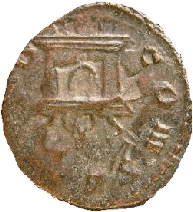
● Next Meeting Status:
Cancelled



● Host Society for the
BANS 2011 Congress
held in Southport


Where to next?

An Unusual Brockage Of Emperor Claudius II
Overstruck With The Correct Reverse
The term 'Brockage' is of relatively recent origin, one dictionary reporting that its earliest appearance was in 1879. It is a word which derives from the English dialect word 'brock' meaning 'rubbish' and reflects what moneyers and the public probably thought about the faulty coins which now bear the name.

A brockage is a coin which has been mis-
Brockages are known for coinages throughout the ages, from the coins of classical antiquity, to modern times. Somehow they have escaped the quality control process which would, normally, have returned them to the melting pot for recycling.

This note looks at a coin which has had a slightly different start in life. It is
a common antoninianus, or two-
The obverse shows a standard radiate portrait of Claudius, with the commemorative legend DIVO CLAVDIO signifying that Claudius had been recognised as a god. So far, so good; nothing out of the ordinary!

Billon Antoninianus
Rome Mint c270AD
Sear 11462

The other side of the coin shows, as would any brockage, an incuse and reversed impression of the obverse. But, on discovering that he had created a brockage, the mint worker chose, rather than letting it pass, or returning it to the scrap metal bin, to remove the coin which had stuck to the reverse die and to strike our coin again, resulting in a 'proper' impression of the reverse design struck over the incuse brockage.



The reverse type is the normal CONSECRATIO reverse showing an altar with flames, Sear 'Roman Coins and their Values III' reference 11462. It is at an alignment of 180 degrees with the obverse, a normal Roman practice which suggests that the dies of the pair, obverse and reverse, were fixed in position relative to each other.
This coin formed part of the Normanby Hoard, a massive collection of mid to late third century Roman coins found in Lincolnshire with, in addition to the coinage of the legitimate Emperors, considerable numbers of coins issued by the rulers of the breakaway Gallic Empire. It is struck in very debased billon, probably only around 3 to 5% silver, and of light weight. Traces of the silver wash which originally covered the coin can still be seen.
Chris Leather

